Disclosure: When you click on links to various merchants on this site and make a purchase, this can result in this site earning a commission. Affiliate programs and affiliations include, but are not limited to, the eBay Partner Network
Here’s the 13 most common diesel heater installation mistakes….
…they’re the things that kept on coming up A LOT when I was doing research into installing this diesel heater I bought from eBay in our Jayco Swan.
The instructions that come with these things are terrible. Or non-existent.
(you can see how I installed ours step-by-step here)
This article should help with:
Reducing unnecessary damage.
Improving efficiency.
And most importantly:
Safety.
Let’s get started:
1. Mounting the fuel pump horizontally
The piston in these fuel pumps cause tiny bubbles to form in the diesel.
And if the pump is on it’s side?
The bubbles can’t escape. They build up.
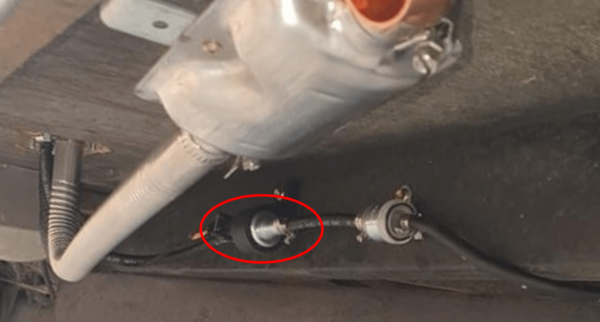
This means the fuel pump wears out more quickly AND the heater doesn’t run efficiently
(it messes with the amount of diesel that reaches the heater)
This is the most common of the diesel heater installation mistakes… but it’s an easy fix:
The fuel pump should be mounted on a 15-30 degree angle to allow the air bubbles to escape.
2. Mounting the muffler sideways (or upside down)
See the little hole on the bottom edge of the muffler?
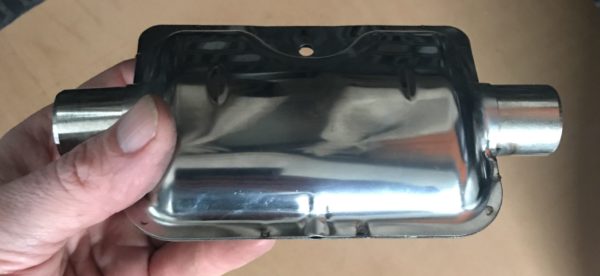
It’s a drainage ‘weep’ hole. It’s purpose is to allow water (a byproduct of the diesel heater’s combusion) to escape.
This muffler is mounted on it’s side:

Upside down, Miss Jane:

So yeah:
The muffler is mounted vertically, not on it’s side, to allow the water to drain out of the weep hole.
This was one of my diesel heater installation mistakes
[I learned that AFTER I’d initially attached it… so I took it off, flattened the bracket, and reattached it]
The good news is when I did this it made it easier for me to avoid another common installation issue:
3. Creating a low point in the exhaust pipe
One of the byproducts of the diesel heater’s combustion is water:
If there’s a bend in the pipe that’s lower than the exhaust outlet, water will collect there.
(and your exhaust pipe will rust more quickly)

The exhaust pipe should slope slightly downwards to prevent water from collecting at the low point.
4. Replacing the fuel line with automotive fuel hose
The hard nylon fuel line that comes with diesel heaters looks DIFFERENT than the fuel hose that people are used to seeing…
… so it’s easy to assume that it’s an inferior product.
No.
This type of fuel line is specifically designed to work with diesel heater systems:
- It’s narrow diameter bore prevents air gaps from forming
- The rigidity stops the absorption of the fuel pulse from the pump
I nearly made the mistake of “upgrading” to automotive fuel hose…
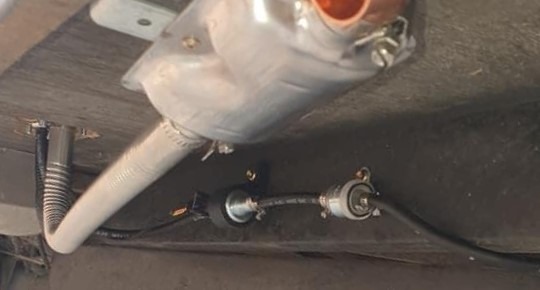
Until I heard from someone who really knows what they’re talking about
[This legend made a 22 minute video going into the ins and outs of the fuel system]
Use the fuel line the diesel heater comes with… if you’re worried about sunlight or stone damage then cover it with some conduit.
5. Mounting the fuel filter after the fuel pump
The aperture in these fuel pumps is pretty small:
They can get clogged up pretty easily
[even a partial blockage will reduce your diesel heater’s performance]

So you want to make sure there’s no sediment getting into the fuel pump.
Mount the fuel filter before the fuel pump to prevent blockages.
6. Installing the fuel filter backwards
I assumed the little basket in the fuel filter was to catch any sediment.
The key word there?
Little.
These fuel filters are designed such that the fuel goes in AROUND the basket
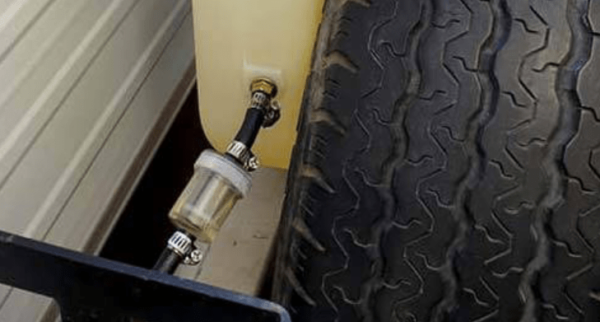
(otherwise the basket would fill up rather quickly)

Mount the fuel filter so the diesel flows in and around the basket. Not into it.
7. Facing the air intake hose forwards
What’s the problem if the air filter is facing forwards?
When you’re driving there’s air, dirt, dust and bugs being pushed into the system at high pressure.
(especially if you don’t have an air filter on the end of it)
Incomplete combustion.
HINT: Some of the diesel heaters are sold with “silencers” that look pretty much like the air filters…
…but bench testing shows they increase the noise!
And they don’t filter. Which makes them useless.
Mount the air intake hose so it’s protected from air being forced into it while you’re driving. And make sure you have an air filter.
8. Installing the diesel heater without any base plate insulation
The fan in these heaters work really well to transfer the heat from the engine to the air ducts:
The base plates don’t get that hot during normal operation
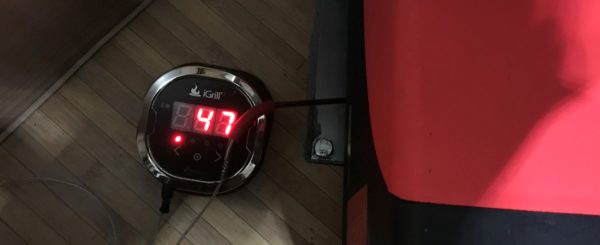
[this was after about 10 minutes on high]
But what happens in the unlikely event that power cuts out?
There’s no way to dissipate the motor’s heat.
Risk = Likelihood x Impact
Sure it’s unlikely… but the potential impact?
This one makes me sleep better at night:
Place some heat resistant silicon, a piece of concrete sheat, or a heat proof chopping board between the base plate and the floor.
9. Fitting the diesel fuel tank nozzle on the bottom
These bottom-mounted fuel tank nozzles are notorious for developing leaks.

And even if that doesn’t happen?
Diesel can be dirty.
If you’ve mounted the fuel tank nozzle on the bottom, you’re guaranteed to get sediment in your fuel lines.
Use a fuel standpipe that’s cut to allow a minimum of 25mm from the bottom… or at the very least side-mount the fuel tank nozzle.

[if your diesel heater doesn’t come with one, they’re less than $10 here on eBay]
UPDATE: Not only does installing a standpipe reduce the risk of spillage… this can provide the option of using a jerry can and using a quick disconnect!
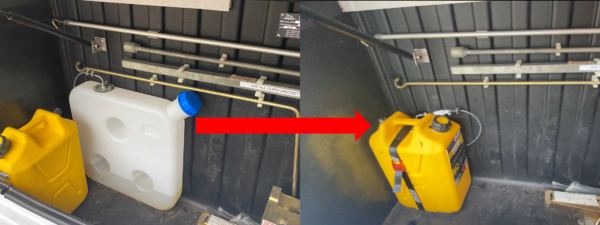
Read: Diesel Heater Fuel Line Quick Disconnect: Installation and Review
10. Drilling a hole in the floor from the top down
If you’re using a hole saw and you only drill from the top down it chews up the wood underneath:
You now have unsealed and unprotected wood that’ll be exposed to the elements when you’re driving
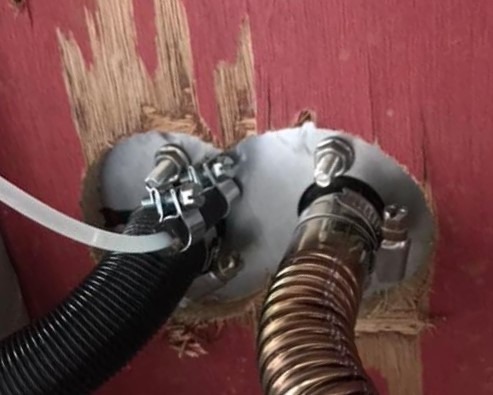
It takes about two seconds to prevent this:
Start drilling the hole from the top, then finish it off from underneath (and use some sealant while you’re at it)
11. Starting the diesel heater for the first time without priming the fuel line
The fuel pump is only lubricated by the diesel itself.
When there’s no diesel?
There’s no lubrication.
And considering the fuel pump dose is a tiny 0.02 ml per stroke?
If you dry start your diesel heater that’s A LOT of metal on metal before the fuel pump gets its first sip of diesel.

[and if it hadn’t had a meltdown, it’d surely have some arthrits for the future]
Unfortunately this isn’t one of the reversible diesel heater installation mistakes.
Make sure you prime the fuel line before you connect the line between the fuel filter and the fuel pump.
12. Pointing the exhaust underneath the van
This one is more of an insurance policy:
These diesel heaters are very efficient and don’t produce much Carbon Monoxide.
But what if they’re not working properly due to:
- Fuel pump not mounted correctly
- Water caught in the exhaust
- Just a plain old malfunction

Next thing you know… Carbon Monoxide trapped under the van.
Now this may never happen, but why take the risk?
Point the exhaust away from the van, not under it.
And if you’re going to ignore this, at least avoid…
Q13. Not installing a carbon monoxide alarm
To be honest:
I was tempted to leave this off this list of diesel heater installation mistakes…
…you shouldn’t actually need a CO monitor
[diesel heaters work by blowing the heat off the outside of a fully contained motor]
But here’s the thing:
Diesel heaters are fully sealed…until they’re not.

Now, it is actually VERY difficult to find examples of these things leaking
(your main concern should actually be problems with the gas system)
Either way, for peace of mind we have one of these Carbon Monoxide detectors by Quell:
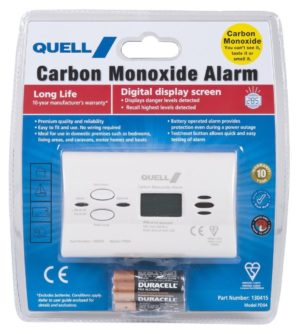
They’re about $45 here from eBay, or just pop down to Bunnings and get one (more like $60 there though)
Summary: diesel heater installation mistakes
So these are the most common diesel heater installation mistakes
(and oftern you see more than one in the same installation)

Hopefully you’re reading about these before you’ve started.
If not, the good news is that most of these are reversible.
To be honest:
Most of the feedback I’ve read hasn’t been due to diesel heater faults, but related to the installation. When done properly, they’re totally a great deal
(so this will be a good head start)
Read: Gas vs Diesel Heaters: Pros, Cons, FAQs (and Myths)
Haven’t bought a diesel heater yet?
Here’s the eBay link to the one we bought (very happy with it)
Comment below if you have any questions. Otherwise, check out 33 Most Popular Caravan Accessories for Travelling Australia

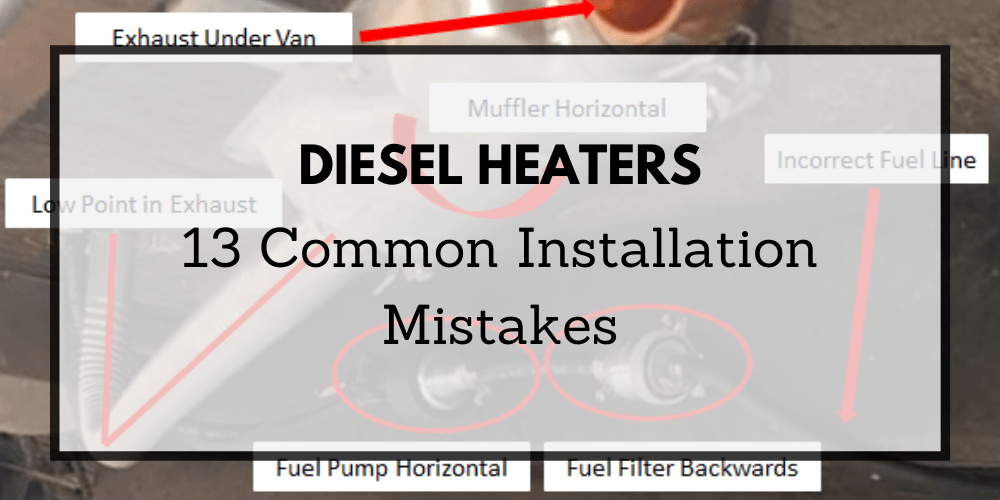
![17 Caravan Gift Ideas for Christmas [2021]](https://abigpeacheyadventure.com.au/wp-content/uploads/2019/11/Caravan-Gift-Ideas-Bamboo-Travel-Mugs-440x264.jpg)
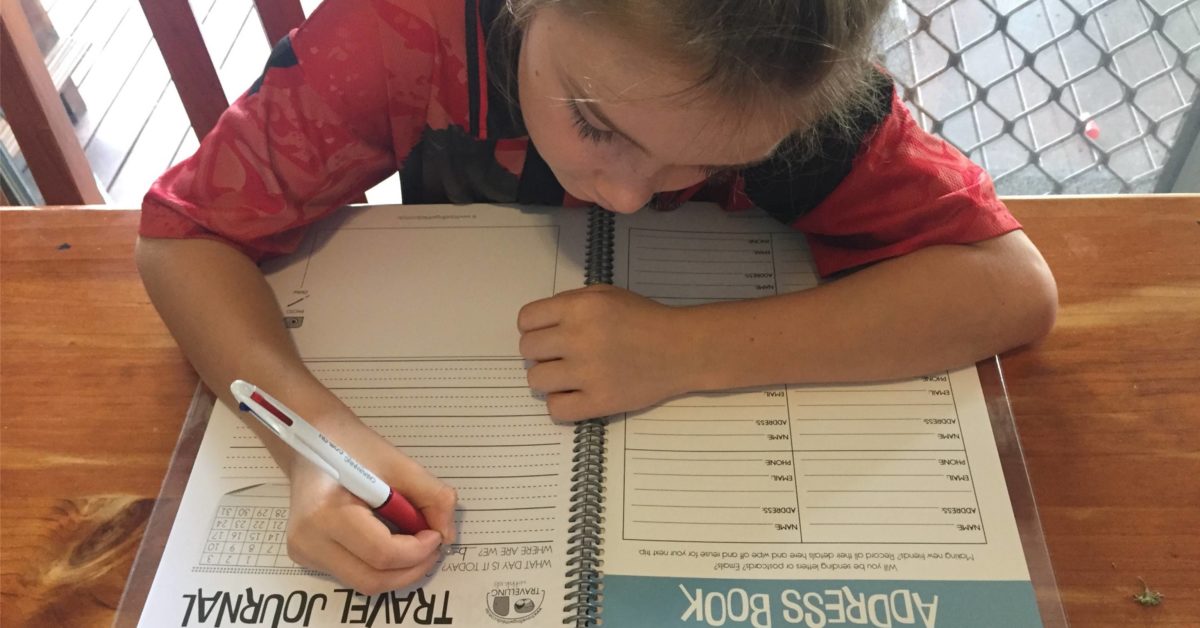

![Caravan First Aid Kit: 33 Essential Items [Checklist]](https://abigpeacheyadventure.com.au/wp-content/uploads/2019/08/Things-to-buy-for-a-new-caravan-First-Aid-Kit-440x264.jpg)
A loud high pitched noise when heater is running, mostly externally.
Great article and I will be checking my installation today as it isn’t running cirrectly.
But (there’s always a but) isn’t there an error regarding fitting the filter before the pump? Unless I’m misreading it first says the filter should be before the pump (correct I think) but then goes on to say mount it after the pump.
Thanks Steve… and you’re 100% right, I mixed up my words! Fixed, cheers
Can you mount the heater vertically?
Hi Doug, unfortunately not
What about upside down? exhaust and intake on top? Does it work in this configuration?
Unfortunately not
Some models can, but they are much more expensive. On the other hand, they also have EU approval so they can be legally mounted in the EU. Some such heaters are sold by tigerexped under the name Autoterm Air / Planar 2D / 4D
Many thanks for this…… Just fitted one of these….and only two minor corrections to make. Could do with a longer exhaust hose than it came with so may look into that… Thanks again, Martin
If you are going for a Carbon Monoxide sensor I would advocate spending the exta $10 and getting the Quell 10 year lithium battery version, $59 from Bunnings . By the time you go through 10 years of energisers and wondering when they are going to go flat (usuallly the middle of the night from my experience) it is well worth the exta. I have also purchased an extension exhaust pipe to take it out the drivers side of the van away from the entry and the door vents. With the install of the unit I cut a 100mm hole in the floor and put in a gal down pipe spigot to give some extra heat shielding. This I also sealed around the timber cut edge with silicone which holds it in place. Also noted about the 12v isolating switch which I also installed to eliminate the bright LED display at night.
Good call!
Thanks for the tips I also found that putting the pump in electric water proof box if outside helps protected from the elements
What fantastic information, thank you.
This info is luxurious! Now if I can only figure out where to mount my heater. Lol Thanks again for this info, I feel so much more confident with the installation process and the units integrity.
Really useful information, found this just at the right time !
Would priming the filter and pipe to pump be enough for first time firing up ?
Hi Paul, yes – the key thing with priming is to avoid the pump cycling without any diesel in it (the diesel lubricates the pump, otherwise it’s metal-on-metal)
Thank you Thank you Thank you! I have been daunted by the prospect of installing my heater. After finding you article I feel so much more confident to tackle the installation. You have laid out the steps and potential problems beautifully.
Hey mate.,
Just some clarification is it best to mount the pump as close to the diesel tank as possible ?
Is it necessary to use the rubber style fuel line connectors like you have ?
Thanks
Hi Troy, yes, that’s correct. The rubber fuel line connectors are neeeded if you’re using the 0.02mm hard nylon diesel lines
Good info, I was looking for info on the fuel line and got the answer here. The clear plastic line didn’t impress me but I guess it’s the correct one to use.
Thanks. Planning to get one soon. The more info the better I feel. cheers.
In the installation instructions of my Vevor heater the filter is shown with the fuel pouring inside the basket, so I will mount it thisway. In general I saw such filters mounted with the fuel pouring around the basket, indeed. Wouldn’t make much difference anyway.